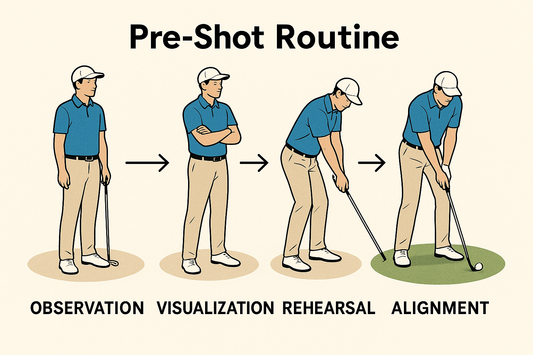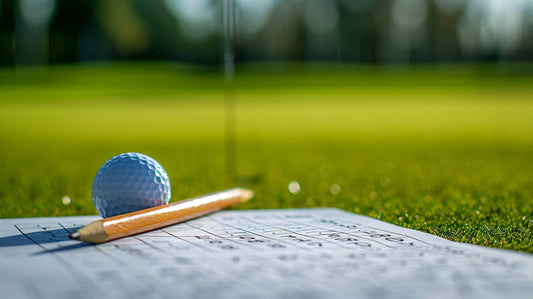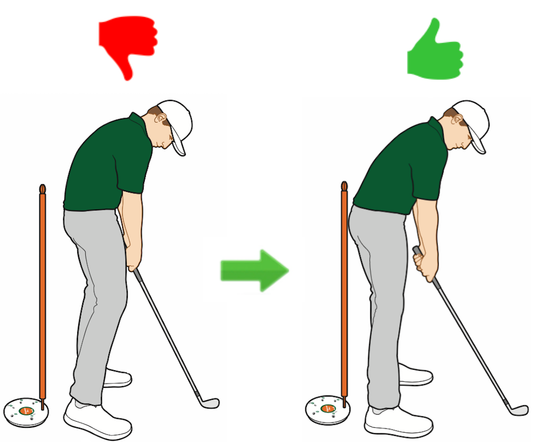Author: WhyGolf WhysGuy
We want to preface this guide with the acknowledgment that neither WhysGuy nor anyone from the WhyGolf team claims to know everything about the golf swing. We don’t want anyone to treat what we say here as gospel. While much of what we’ll say is a reflection of decades of dialogue with PGA instructors and players, we’re always learning and we understand that knowledge about the sport of golf will continue to evolve over time.
In this post, WhysGuy will cover:
- The 8 best golf swing tips that will help golfers along their journey to becoming a better player.
- How WhyGolf training aids can help all golfers learn and improve their golf swings.
The Best Golf Swing Tips
To a person unfamiliar with the game of golf, it would seem that replicating good shots would be easy once a player has done it once or twice. To those who have played golf more than a few times, this is clearly a misguided conception. If consistent success is elusive for those who play the game for a living, what chance do the rest of us have?
Despite the fact that good shots can be extremely difficult to deliver on command - it's precisely this fact that keeps us coming back to the game.
Here are 8 golf swing tips that will get you hitting those picture-perfect golf shots more often.
1. Get Your Grip Right
The grip is perhaps the most important fundamental to get right in the golf swing. It is the one point of contact between you in the golf club.
The key is to make sure to start with your left hand on the club first.
Here’s what Golf Digest said about developing a proper grip. “Always put your left hand on first, because it's your guide to sensing the alignment of the clubface, then add your right hand. As you look down at your grip, make sure your left thumb rests slightly to the right of the top-center of the shaft.”
On your left hand, your thumb and index finger will establish a “V” - you want to make sure your “V” is pointing at your chest, which is an indication that you've arrived at a neutral grip. The closer your "V" is to your trail shoulder, the stronger your grip.
If you're new to the game, it's imperative to start building good swing habits from day one. Why? The more you train your muscles to move a certain way, the harder it will be to change the movement pattern.
2. Use Alignment Aids
The best golf swing in the world will not produce results if the golfer's alignment doesn't match where they think they're aiming. Golfers can often develop bad swing habits as a result of having to compensate for bad alignment. If your alignment is not in sync with where you think you're aiming, you may find yourself compensating with your golf swing, which will end up further complicating things.
For example, if a golfer is unintentionally aiming to the right of their target, they may subconsciously begin to come over-the-top to start the ball on their intended line (for right-handers). They may then try to fix their over-the-top move, but really it was bad alignment that was the root cause of their problem. Before you try to change your golf swing, it's critical that you make sure you're aligning yourself correctly.
You can avoid your next downward spiral by using alignment tools in each practice session. If you do need to work on your swing plane, our Alignment Disc and Padded Alignment Rods can make it easy to stand alignment rods upright and move them as needed. Learn more about the different ways you can use alignment rods here.
3. Use Golf Clubs that Fit You and Your Golf Swing
If you're looking to make the game harder than it needs to be, you should opt for heavy, stiff shafts and steer clear from forgiving irons.
If you want to play your best golf, it's best to use golf clubs that fit your skill level and physical capabilities. While it's pretty cool to show your friends your new forged muscle-back irons, it's way cooler to optimize your scoring potential with forgiving game-improvement irons that will actually improve your ball striking.
For newer players looking to purchase new golfing equipment, keep the following tips in mind:
- Driver: Make sure it has 10.5 degrees of loft (or more). Loft is your friend and will help you hit it longer, even if you don’t have a high swing speed (yet).
- Add more fairway wood and hybrids: Get rid of heavy, hard to hit long irons and use high-lofted fairway woods and hybrids instead. These clubs are more forgiving, launch the ball higher, and don’t have as big of mishits.
- Get fitted for golf shafts: While the clubs are important, don't forget about the shafts too. As a beginner golfer, it’s generally a good idea to opt for graphite shafts for your irons; these lighter shafts make it easier to swing faster and hit it longer.
Plus, don’t forget to find a putter that is very forgiving (mallets are more forgiving than blade putters).
4. Shift Your Weight and Pressure Properly
Power comes from the ground up in the golf swing. This is a critical golf swing tip.
If you watch advanced golfers, you will see they actually push off the ground to generate power and force on their downswing. But if you watch a lot of beginner golfers they neglect their lower body and instead, use their upper body to start the downswing. We wrote a whole article about how to increase your swing speed here.
- To start hitting the golf ball more consistently, you must learn how to transfer your weight and pressure effectively.
- At setup, your weight is roughly 50/50 or slightly forward of center (for most shots).
- On the backswing, pressure should spike into the inside of your trail foot - without swaying. This allows you to “load up” and generate power.
- On the downswing, as you lead with your lower body, the majority of your weight and pressure should be applied to your lead side before impact. This will allow you to unload your power and hit the ball with force.
But this isn’t always something easy to feel in your golf swing. This is why we created the Pressure Plate - a simple tool to help you feel your weight transfer in the golf swing. The device ensures you don’t sway or keep your weight on your back foot, and instead move weight to your lead side. When you learn how to shift your weight properly, you will tap into your power and strike the ball with more consistency.
5. Keep Your Arms in Sync in Your Golf Swing
Your arms play an enormous role in your golf swing. If you hit a lot of thin or fat shots, you'll want to make sure your arms are working together and are in sync with your chest throughout your golf swing. Poor arm structure can manifest itself as a flying elbow or a chicken wing in the golf swing.
Generally speaking, it's wise to keep your arms from separating too much throughout the entire golf swing so as to eliminate unnecessary movement.
Additionally, you'll want your arms fully-extended at impact. But this is easier said than done for most golfers!
If you want to work on your arm structure, ArmAlarm will give you real-time auditory feedback while you make your swing. Strap the band around each wrist and if your arms separate too much, you will hear the beep.
6. Don't Go For Every Pin
Any golfer looking to score better can do so by playing more conservatively. By aiming at the middle of the green, you're essentially maximizing the number of scenarios where your ball will end up on the green.
For example, if you aim directly at a pin that is tucked to the left edge of a green, a significant percentage of your shots will end up missing left of the green (no matter how good you are at golf). When faced with a tucked pin, it's generally best to aim toward the center of the green, and if you miss left, you're in great shape. If you hit your mark, you have a medium-length putt. If you miss right, you're still likely going to be on the green.
It's really all about understanding your golf game and playing the percentages. It's a simple fact that your chances of getting up-and-down from off the green are much worse than your chances of two-putting from 35 feet.
7. Learn How to Escape the Bunker
As a beginner, you aren't expected to be a wizard out of the sand. However, you'll do yourself a huge favor by learning a few basics about proper bunker technique.
Keep it simple with the following bunker tips:
- Use your sand wedge, choke up 1–2 inches on the grip, and open the face. Most golfers get intimidated by opening the face but this is needed in the bunker!
- Make sure the ball position is in the front center of your stance with slightly more weight on your lead foot.
- Hinge your wrists quickly - this will help add speed and make it easy to accelerate through heavy sand. Focus on a spot 1–2 inches behind the golf ball. Remember, you don’t hit the ball, you hit the sand which carries the ball out of the bunker.
- Focus on a spot behind the ball where you want the club to enter.Accelerate through the shot with plenty of speed.
- If you don’t have a practice bunker at your driving range, make sure to try our Bunker Mate. This tool allows you to practice bunker shots from anywhere (no rake is required either). It’s a great addition to your indoor golf simulator too!
8. Practice Your Short Putting
While most beginners focus on the full golf swing, you can separate yourself from the masses by spending a little effort on your putting. You can lower scores quickly if you're able to consistently make putts inside four feet. Statically, these are “low-hanging fruit” when it comes to saving shots each round.
During practice, make sure to spend a few minutes before or after the driving range working on short putts. Here are some easy golf swing tips to help you make more short putts:
- Make sure your putter is aligned correctly at setup.
- Develop a consistent routine on which you can rely when you're ou on the course.
- Have a light grip pressure on the club to remove tension in your arms.
- Always accelerate through the stroke.
Best Golf Swing Tips - Key Takeaways:
- Master the fundamentals like your grip, posture and alignment to establish good habits in your golf swing.
- Make sure your clubs fit you and your golf swing.
- Use training aids to get feedback on different aspects of your game to improve your golf swing faster.
- Be more conservative with your target selection (if you want to lower your scores!).
- Don’t forget that golf is a hard but very rewarding sport. Stay patient and enjoy the journey - don’t forget everyone sucks in the beginning. Stick with it!
Ready to fast-track your golfing progress? Explore our full suite of golf training aids here.
What are 3 best golf tips for beginners?
Use alignment aids in practice, work on your short game more often, and have the right mindset when playing golf. Without the right mindset, it’s easy to get frustrated, want to break clubs, and give up on this great game. Make it your goal to get curious, not furious after every swing so you can learn from your mistakes.
What's your best golf swing tip?
Our best swing tip would be to try to keep it as simple as possible. Overthinking in the golf swing is a performance killer. It's important to avoid thinking too much about mechanics in your golf swing when on the golf course and especially in competition.
Leave the technical thoughts on the driving range and when you’re out on the course, focus on just playing golf. This will help you have more fun and not get bogged down with your golf swing thoughts.
What's the best way to practice my golf swing?
The best way to practice your golf swing is to set aside 20 minutes every practice session to work specifically on your golf swing. During this time, it's best not to worry about making good contact with the golf ball or where the ball goes - you're only focusing on making a change to your golf swing. After your 20 minutes is up, find a swing thought that you feel is conducive to that specific swing change and stick with it for the rest of the day while you practice or play.
Best way to increase speed in golf swing?
Swing speed can be increased in the golf swing by improving your physical fitness, particularly your flexibility and strength. Exercises targeting your core, glutes, and shoulders can help. Additionally, perfecting your swing mechanics, like optimizing your weight shift and maintaining a smooth tempo, can also boost your swing speed. If you want to read more, check out this article.
What should a beginner practice in their golf swing?
Beginner golfers should practice their grip, alignment, and short game in every session. Your grip affects path and club ace so make sure you spend plenty of time with this important skill.
Alignment is another very important piece of golf because if your golf swing alignment is off, it’ll negatively impact your golf swing and create bad habits. Finally, your short game is key to learning how to save shots from short range when you miss the greens.
What's the hardest thing about the golf swing?
The hardest part about the golf swing is making swing changes. The golf swing is not something that can be changed easily. It takes time and dedication to change your swing and spend enough time practicing so that your changes feel natural.
Golf is not a sport you can start playing today and be shooting in the 90s or 80s tomorrow. There are so many aspects to the game that it’s a steep learning curve at times. Stay patient, enjoy the process, and try to get 1% better every time you practice.
How long will it take to improve my golf swing?
It's best not to have expecations as to how long it'll take to change your golf swing. Plus, every golf swing change is different by nature and some may take longer than others. Our best golf swing tip as it relates to changing your golf swing is to simply be patient and work at it. Also, don't be afraid to practice in your bedroom or garage!
Check Out Our YouTube Channel For Drills and Tips









